Cell Quiz
5.0(1)
Card Sorting
1/83
Study Analytics
Name | Mastery | Learn | Test | Matching | Spaced |
|---|
No study sessions yet.
84 Terms
1
New cards
Cell Theory
all living things are composed of cells; cells are the basic units of structure and function in living things; new cells are produced from existing cells
2
New cards
Who created the cell Theory?
Schleiden, Schwann, and Virchow
3
New cards
Prokaryotic cells
cells that have no nucleus and membrane-bound organelles; smaller and simpler than eukaryotic cells; ex: bacteria
4
New cards
Eukaryotic cells
cells that have a nucleus (containing DNA) and dozens of structures and internal membrane-bound organelles; gernerally larger and more complex than the other cells; most are highly specialized; ex: plants, animals, fungi, and protists
5
New cards
All cells
surrounded by a barrier called a cell membrane, have DNA, and classified based on whether they have a nucleus
6
New cards
Organelles
structures that have important functions
7
New cards
nucleus
contains most of the cell’s DNA (genetic material)
8
New cards
nucleolus
it produces a type of RNA, ribosomal RNA, and joins rRNA with proteins to form the subunits of ribosomes
9
New cards
nuclear envelope
it has nuclear pores to permit the passage of ribosomal subunits and mRNA out of the nucleus and into the cytoplasm and the passage of proteins from the cytoplasm into the nucleus
10
New cards
Genetic Material (DNA or chromatin)
diffuse threads containing DNA and protein and controls the development of, maintenance, and reproduction of organisms
11
New cards
ribosomes
makes proteins; are small particles of RNA and protein found throughout the cytoplasm
12
New cards
Endoplasmic Reticulum
assembly area for lipids, proteins, and some other materials that are exported from the cell; smooth/rough
13
New cards
Rough ER
studded with ribosomes and synthesizes and modifies proteins
14
New cards
Smooth ER
lacks ribosomes, synthesizes lipid molecules, and forms vesicles that transport molecules to other parts of the cell
15
New cards
Golgi Apparatus
modifies, sorts, and packages proteins and other materials
16
New cards
Lysosomes
small organelles filled with enzymes; breaks down lipids and carbohydrates; also breaks down organelles that have outlived their usefulness
17
New cards
Vacuoles
stores materials such as water, salts, proteins, and carbohydrates
18
New cards
Vesicles
cellular packages containing products such as protein
19
New cards
Mitochondria
converts the energy stored in food into energy the cell can use; site of cellular respiration
20
New cards
Chloroplasts
captures energy from sunlight and converts it into energy the cell can use (photosynthesis); contains the green pigment chlorophyll
21
New cards
Cytoskeleton
gives shape and internal organization to eukaryotic cells; made up of microfilaments and microtubules
22
New cards
centrioles
organize microtubules that serve as the cell’s skeletal system; located inthe cytoplasm of an animal cell near the nuclear envelope; determine the locations of the nucleus and other organelles within the cell
23
New cards
What do prokaryotic cells have?
no nucleus, less features/organelles (no membrane-bound organelles), unicellular, less complexity, usually smaller, and ex: Bacteria
24
New cards
What do eukaryotic cells have?
have a nucleus, has membrane-bound organelles, multicellular, more complex, usually bigger, cell specialization, and ex: plant, animal, and fungi
25
New cards
All cells have a
cell membrane
26
New cards
Cell Membrane
regulates what enters and leaves the cell, provides protection and support, and made up of a __phospholipid bilayer and protein__; helps the cell and organism maintain a steady internal environment
27
New cards
Cell Wall
provides support and protection; found in plants, fungi, algae, and some prokaryotes
28
New cards
Every living ____ exists in a _____ environment.
cell; liquid
29
New cards
What is diffusion?
one way things move into and out of the cell
30
New cards
What happens during __diffusion__?
particles move from high concentration to low concentration until it reaches equilibrium; depends on random particle movement so no energy is needed
31
New cards
Equilibrium
when the concentration of the solute is the same throughout (both sides of the cell)
32
New cards
Osmosis
the diffusion of __water__ through a ==selectively permeable membrane==; water moves from high concentration to low concentration
33
New cards
Isotonic
when the concentration of water and solute are the __same__ on both sides of a membrane
34
New cards
Hypertonic
when there is __more__ solute than water
35
New cards
Hypotonic
when there is __less__ solute than water
36
New cards
What pressure does osmosis exert?
Osmotic pressure
37
New cards
In order to survive, organisms need a way to balance the ______ and ______ of water
intake; loss
38
New cards
Cell membranes have _____ ________ which allow certain molecules to cross easily
protein channels
39
New cards
__Facilitated diffusion__
proteins help some particles move across a membrane; is fast and specific (due to protein structure); only occurs if there is a concentration gradient (high on one side, low on the other)
40
New cards
Passive Transport
moves particles (molecules and ions) across the membrane with the concentration gradient (high to low); does not require energy
41
New cards
Active Transport
mvoes particles against the concentration gradient (low to high); requires energy (ATP); small molecules and ions are carried across by proteins in the membrane
42
New cards
Endocytosis
process of taking things into the cell by infoldings of the cell membrane; the pocket then breaks free of the membrane and forms a vacuole inside the cell; ex: phagocytosis and pinocytosis
43
New cards
Phagocytosis
taking in large amounts of solid material; “cell eating“
44
New cards
Pinocytosis
taking in large amounts of liquid; “cell drinking”
45
New cards
What color does a substance or solution turn into when starches are present after being tested by iodine?
blue-black
46
New cards
What color does a substance or solution turn into when glucose is present after being tested by Benedict’s Reagent?
green, yellow, yellow-orange, orange, orange-red, red
47
New cards
Unicellular
organisms made up of only one cell
48
New cards
Multicellular
organisms made up of many cells; a great variety among these organisms
49
New cards
What is cell specialization?
(only in Eukaryotic cells) cell throughout an organisms can develop in different ways to perform different tasks; anial cells are specialized in many ways
50
New cards
What are the four levels of organization in a multicellular organism?
individual cells, tissues, organs, organ system
51
New cards
tissues
a group of similar cells that perform a particular function
52
New cards
organs
groups of tissues that work together to perform a specific function
53
New cards
organ system
a group of organs that work in systems; they come together to make up an organism
54
New cards
Plant cells vs. Animal cells
plant cells: chloroplasts, a large permanent central vacuole, and a cell wall
animal cells: lysosomes, centrioles, temporary vacuoles, and vesicle
animal cells: lysosomes, centrioles, temporary vacuoles, and vesicle
55
New cards
Tonicity
the ability of a solution surrounding a cell to cause that cell to gain or lose water; strength of the solution
56
New cards
Hypotonic in Elodea Cells
chloroplasts are moving; pressed against the cell wall
57
New cards
In a ____ solution, the central vacuole of a plant exerts _______, and the chloroplasts are seen up against the cell wall.
hypotonic; tugor pressure; pushed
58
New cards
Hypertonic in Elodea Cells
chloroplasts are at the middl eof the cell, not moving, and bunching together
59
New cards
In a _____ solution, the central vacuole ____ water, and the cytoplasm including the chloroplasts have ______ away from the cell wall.
hypertonic; loses; pulled
60
New cards
The Sandwhich Model
the phospholipid bilayer filled between two continuous layers of proteins plus the hydrophilic heads and hydrophobic tails of the phospholipids
61
New cards
Unite Membrane Model
all membranes in various cells have basically the same composition
62
New cards
Fluid-Mosaic Model
the membrane is a fluid phospholipid bilayer in which protein molecules are either partially or wholly embedded; proteins form a mosaic pattern
63
New cards
Phospholipid
a molecule that has both a hydrophilic region and a hydrophobic region; hydrophilic polar heads face the outside and the insde of the cell, where water is found; hydrophobic nonpolar tails face each other
64
New cards
Cholesterol
another lipid found in animal plasma membrane; related steroids are found in the plasma membrane of plants; it stiffens and strengthens the membrane, helping regulate its fluidity
65
New cards
Proteins in a membrane can be ______ proteins or ______ proteins
peripheral; integral
66
New cards
Peripheral proteins
when they are on the inside surface of the membrane, they are often held in place by cytoskeletal filaments
67
New cards
Integral proteins
embedded in the membrane, but can move laterally back and forth; can protrude from only one surface of the bilayer; span the membrane, with a hydrophobic region within the membrane and hydrophilic regions that protrude from both surfaces of the bilayer (transmembrane proteins)
68
New cards
Both phospholipids and proteins can have attached carbohydrate (sugar) chains, ______ and _____ respectively
glycolipids; glycoproteins
69
New cards
Two sides of the membrane are not
identical
70
New cards
Glycocalyx
carbohydrate chains of proteins as a “sugar coat” ove a cell; protects the cell and has various other functions
71
New cards
Carbohydrate chains can vary greatly by the _____ and ___ of sugars and by whether the chain is ________
number; sequence; branched
72
New cards
Lipid components
they decide the fluidity fo the membrane which is critical to its proper functioning
73
New cards
The ____ the concentration of unsaturated fatty acid residue, the ____ more fluid is in hte bilayer which increases the membrane’s fluidity
great; more
74
New cards
Can the proteins not held in palce by cytoskeleton drift laterally in the fluid lipid bilayer?
yes
75
New cards
A membrane’s fluidity is needed for some
protein’s function (ex. enzymes)
76
New cards
Enzymes are _____ when membranes are solidified
inactive
77
New cards
Plasma membranes of various cells and the membranes of various organelles each have…
their own unique collections of proteins that form different patterns according to the particular membrane and also within the same membrane at different times
78
New cards
Integral proteins examples
channel proteins, carrier proteins, cell recognition proteins, receptor proteins, enzymatic proteins
79
New cards
Channel proteins
help move molecules and substances across a membrane
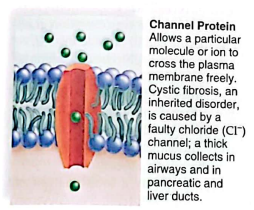
80
New cards
Carrier proteins
combine with a substrate to move it through a membrane
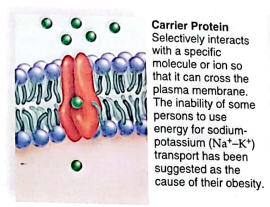
81
New cards
Cell recogition proteins
help the body realize when pathogens are invading so an immune reaction can occur
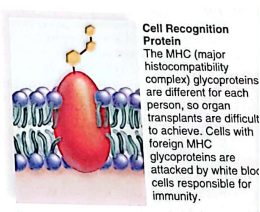
82
New cards
Receptor proteins
bind to specific molecules which causes a protein ot change shape and bring about a cellular response
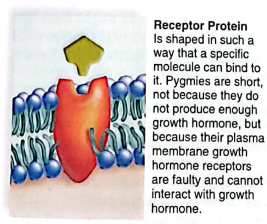
83
New cards
Enzymatic proteins
carry out metabolic reactions directly
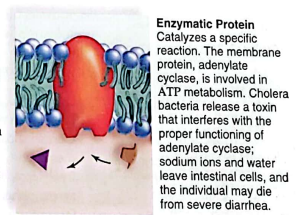
84
New cards
The peripheral proteins often have a _____ role in that they help ____ and _______ the plasma membrane
structural; stabilize; shape